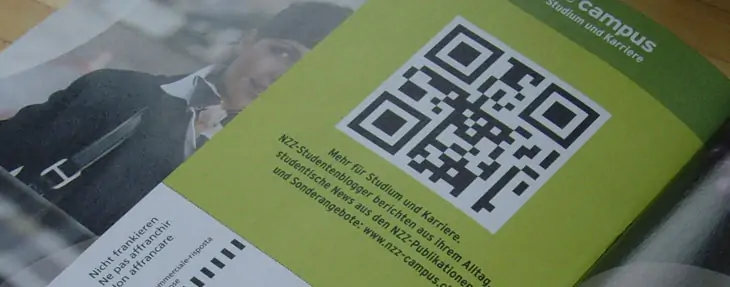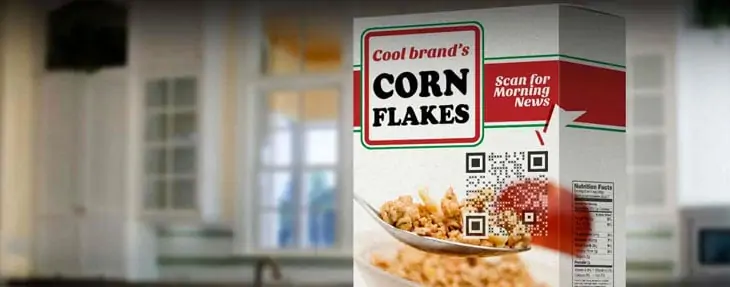QR codes and how to use them in an ecommerce business
QR codes are the future of all online industries, and ecommerce is no exception. They have the potential to revolutionise the way we shop, or at very least make the process a lot more convenient for everyone involved. Here’s a quick go to guide on what they are and how they can help your ecommerce business.
What is a QR code?

An abbreviation of “Quick Response code”, QR codes are 2D images made up of either lines, dots or other formats that can be read by smartphones and other devices. You can scan them with your screen and be linked directly to a website, provided with particular information, linked to a phone number or text and various other functions.
QR codes have become a massive hit in south-east Asia and Japan, where they were originally used by the car manufacturer Denso Wave as a more elaborate version of the traditional barcode. They’ve caught on in the region, partly due to the fact that they can contain far more information than their predecessor, storing up to 7,089 numbers as opposed to a 1D barcode’s capacity of 30. This has enabled them to link to data such as social media posts, videos and website pages which, as a result, has caused them to since spread to the rest of the world.
So why should I care about them?
Because everyone’s going to be using them soon and you need to be prepared for when that happens.
The number of smartphone owners in the UK and USA is at its highest level ever, and is continuing to grow fast. Currently 76% of British adults own a smartphone, alongside just under two-thirds of Americans, the latter figure almost doubling in the past four years. Yet the ownership numbers themselves are surpassed by usage and purchase figures. In the UK, smartphones are checked over a billion times daily, with over half of users looking at them within five minutes of waking. An astonishing 38 million new phones are bought or handed down every year.
QR codes have enormous potential to change the way marketing, advertising, customer services and many other industries operate, all of which can be utilised or epitomised by the ecommerce industry.
How can I make a QR code?
Thankfully, you don’t need to be a digital whizzkid to create one of these, as there are already websites specifically designed to help generate them. Although you should try out a wide variety before deciding which ones work best for you, here are a handful to get you started:
You can also make QR codes any size and use many different formats when creating them, including HTML code, Tiff files, PNG files, SVG and EPS.
Where can you put them and how does that help me?
QR codes are best used on print or similar formats as a means of linking people to a digital platform. So for instance, you could put one on a clothes tag and it will link you to a video which shows a group of people modelling that outfit.
Producing a comprehensive list of all available platforms to place QR codes on would leave you with an exhaustive collection, but here are some of the main ones that ecommerce companies can put to good use:
Magazine or newspaper adverts
It’s difficult at the moment to encourage someone to make the leap from reading an advert about a website in the newspaper to physically searching for it online. Being able to include QR codes in the advert itself makes this process far simpler and quicker, which makes print media advertising a more promising prospect than beforehand.
Leaflets and flyers
Although major companies in the ecommerce industry may want to focus their budgets on advertising campaigns, smaller start-ups would likely not have the capital to invest in such ventures. As explained above, print media has usually not been a lucrative prospect for such websites, but the ability to scan QR codes on objects such as leaflets may make them a more rewarding method to try.
Packaging
If your customer orders a physical object online that you have to send to them, rather than including a chunky manual that costs money to print, you now have the alternative option of simply including a QR code on the material that they can scan to find the information.
Booklets
Many online shops provide paper-based booklets containing all of their products and services, something along the lines of the better-known Argos catalogue. These items take on a whole new dimension of customer service when you add QR codes to some or all of the products, as they enable customers to find the exact purchase they want instantly on the website, without the hassle or stress of trying to navigate their way towards it.
How to use QR codes for marketing

Before storming in and placing QR codes on everything you’ve got, you have to bear in mind how the public continues to view this new invention.
As a general rule of thumb, it’s best to assume that QR codes are still seen as “special” barcodes, links to alternative and somewhat better products and content than the user could have otherwise found. However, if you want to take a gamble and use them for everything then best of luck – after all they are a new concept and, like all fresh ideas in the market, need the odd pioneer every now and again to be taken to another level.
It’s also important to remember that they aren’t quite commonplace yet and, as a result, not everyone knows what they are or how to use them. Therefore it helps to provide instructions alongside any QR code. We’d also recommend including links to sites or apps where the user can download their own QR code scanner.
If used effectively, a well-coordinated QR code campaign could help raise awareness of your brand as they can link to a variety of your multimedia platforms, from Twitter pages to company blogs. They can also help you stave off competition from fake producers by ensuring customers that your products are the genuine make.

Comments are closed.